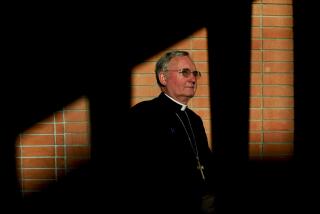HIV patient Timothy Brown is the boy who lived
- Share via
To many of the nation’s million people living with a diagnosis of HIV/AIDS, Timothy Brown is the Harry Potter of the disease: Like the young wizard who survived Lord Voldemort’s wrath, he is the boy who lived.
Today, almost 20 years after he became infected, Brown is, essentially, cured.
Brown, now 45, is known in medical-journal circles as “The Berlin Patient,” a moniker assigned him by a February 2009 case study published in the New England Journal of Medicine.
In a “Brief Report,” oncologist Gero Huetter and his colleagues at Berlin’s University Hospital described the unique stem-cell transplant of an HIV-infected patient — Brown — who had acute myeloid leukemia, and the remarkable result: Twenty months after the procedure, the virus had not reappeared in Brown’s body, even though he was no longer taking antiretroviral drugs.
The bone marrow Brown received in a time-tested treatment for leukemia had given him an extraordinary gift. It had also transferred to Brown’s immune system an uncommon genetic variation — present in an estimated 10% of northern Europeans — that rendered it resistant to HIV.
It’s been a winding road to medical fame, Brown said in an interview last week. Raised in Seattle, he came out as gay at 18 and soon began a restless journey across Europe. He settled briefly in Barcelona, where he believes he became infected, and finally in Berlin, where he lived for almost 20 years.
When he learned he was HIV-positive in 1995, a friend told him gravely that he probably had two years to live.
“I didn’t know who to be angry at,” Brown said.
Ten years later, he was alive and taking antiretroviral medications. Then, in 2006, a bout of exhaustion sent him to the doctor, who diagnosed leukemia and proposed the customary treatment: Wipe out Brown’s immune system with radiation and rebuild it with the bone marrow of a healthy donor.
Here was the crucial trick: From the 230 possible matches found for Brown, Huetter deliberately picked a donor who carried genetic resistance to HIV, hoping they might lick both diseases in a single shot.
Now living in San Francisco, Brown has found himself a bit of a celebrity at AIDS functions around the city. Two weeks ago, he spoke at an event titled “Cure — Still a Four-Letter Word?” organized by the American Foundation for AIDS Research. Afterward, he says, “everybody wanted to get their picture taken with me.”
It was as if, he said, he had become the living, breathing embodiment of hope for an end to AIDS.
For much of the AIDS pandemic’s first 30 years, talk of a cure was indeed a four-letter word, widely dismissed as fanciful and detracting from the real job of prevention and treatment — and a dangerous spur to false hopes and complacency.
But as Brown’s fame has grown, the “cure” word has lost its taboo.
Last week, the nation’s chief scientists in the fight against HIV/AIDS — Drs. Carl W. Dieffenbach and Anthony Fauci of the National Institute of Allergy and Infectious Diseases — also abandoned their reluctance to talk about a cure for the pandemic that has killed nearly 30 million people.
Certainly, the treatment Brown received could not be applied to the millions of people infected with HIV — it is far too risky and expensive for that. But its results offer proof that there are ways to turbo-charge the immune system to prevent and even fight off established infection without taking a cocktail of pills everyday, the officials wrote in the Annals of Internal Medicine.
Brown sustained a brain injury in a 2009 mugging in Berlin, and walks and speaks with some difficulty But he sees himself as lucky and says he’s glad to be a “catalyst” to the development of a more practical AIDS cure.
“It’s an incredible feeling — like a miracle,” he said. “I had two lethal diseases and was able to get rid of both of them.”
More to Read
Sign up for Essential California
The most important California stories and recommendations in your inbox every morning.
You may occasionally receive promotional content from the Los Angeles Times.














